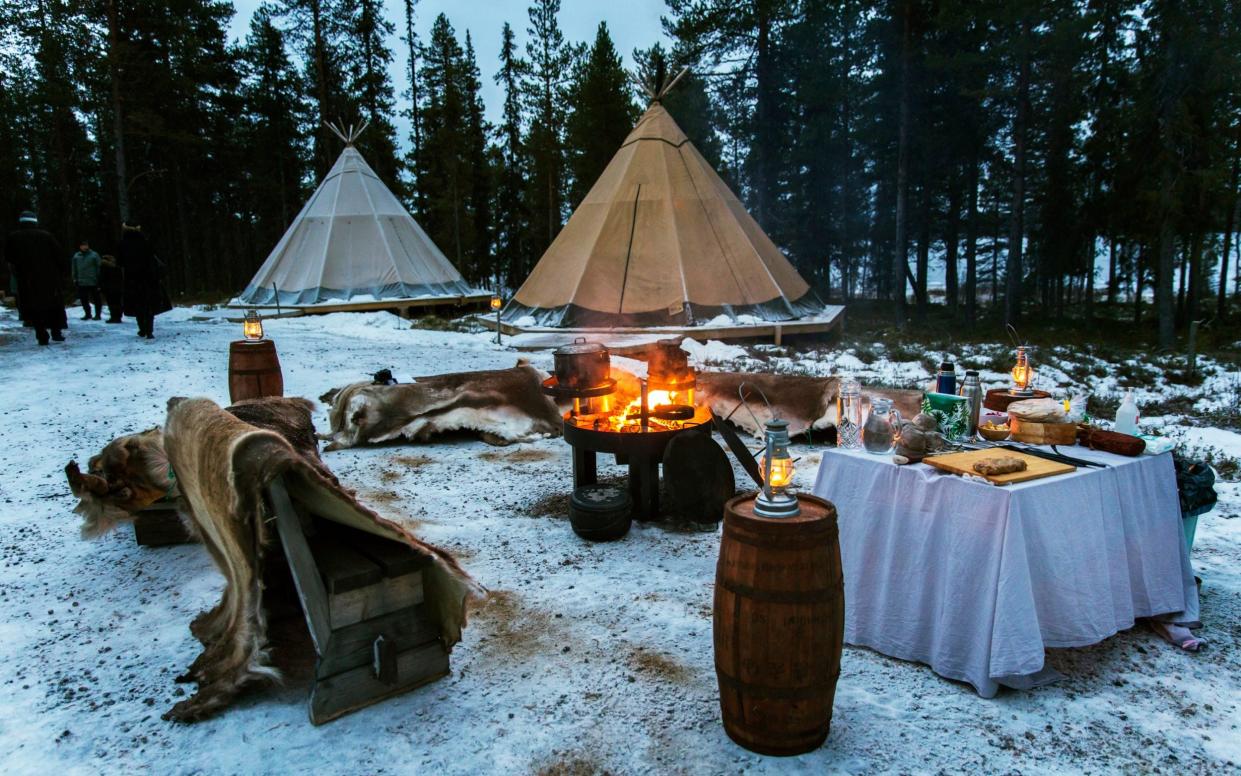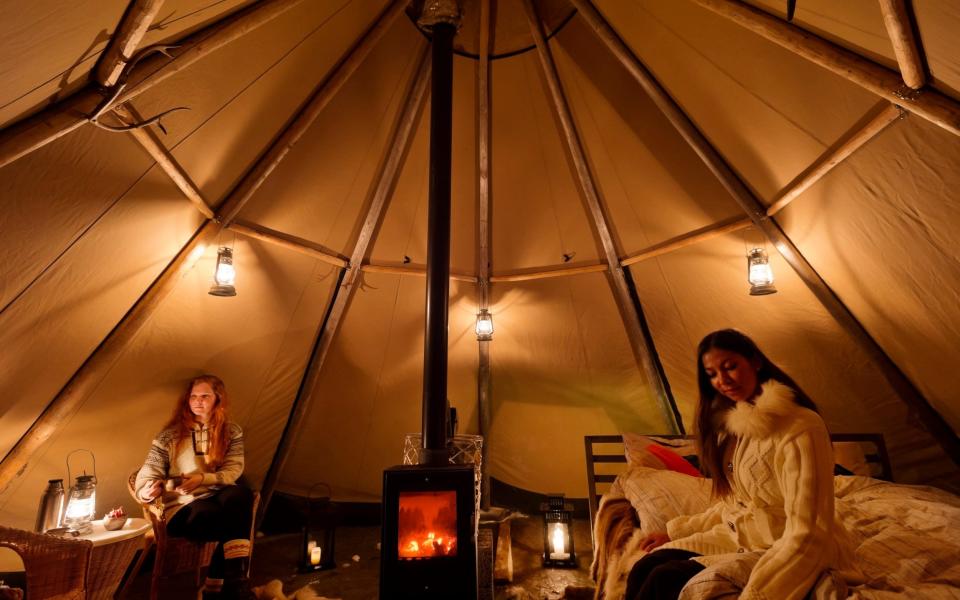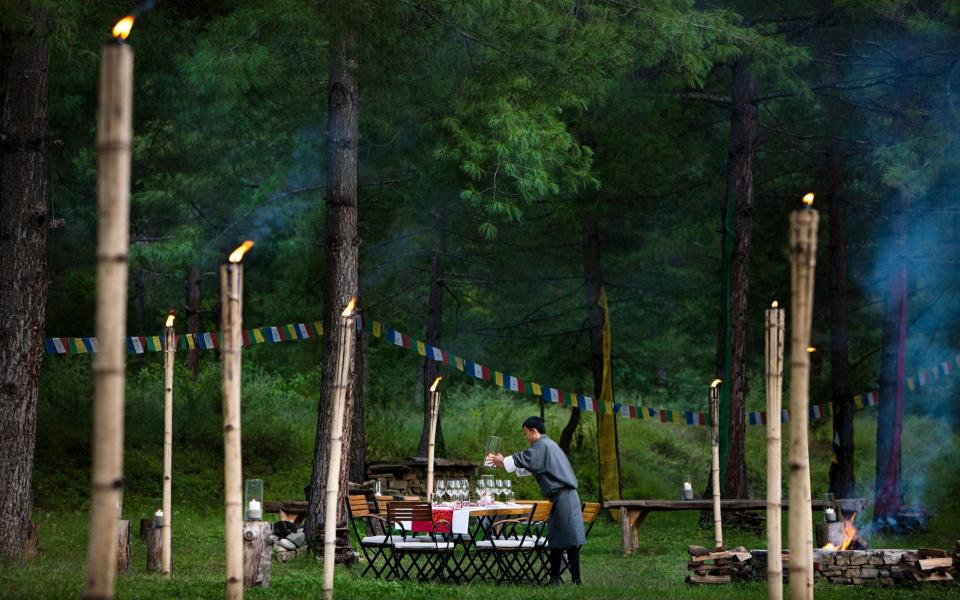The luxury wilderness retreat that is reinventing camping

It was only late morning but the shadows were already long, foretelling the end of the short day. The light fades quickly in winter in the northern Sapmi region of Sweden, when the sun rises but only lifts itself a few degrees above the horizon.
I had come here, north of Jokkmokk, above the Arctic Circle, to find the Sapmi Nature Camp on the banks of the Lule River, a pitch of six tents, each a teepee-like structure called a lavvu in Sami, decorated with reindeer hides and warmed by a wood-burning stove.
It might not be luxury in the traditional sense given there is no running water or electricity, but rustic camps such as this one promise a place free from the tangle of rules and regulations we are enduring in our search for simpler settings – and the price rises accordingly.
Some of the smartest hoteliers are going back to basics now: COMO and Aman offer a one-night tented experience in the Himalayas bookended by stays in their comfortable lodges in Bhutan. These nights out can cost the same as a night cosseted in the hotel. Some might think the prices don’t align; I’d argue guests are getting more for their money out in the fresh air.
Also in on the action, tour operator Black Tomato created a service, Blink, to pitch bespoke camps anywhere guests might desire with a price tag that reflects the costs of operating in remote areas. Just like at Sapmi Nature, what travellers pay for is the rare access, the logistics and in-built contingency, as well as the specialist guiding.
I pulled on some snowshoes, drawing the criss-cross straps tight over the bridge of my boots and buckling them behind the heel. Then I stomped down the deep snowy banks, ungainly, and out onto the frozen Lule River, which stretches from the Scandinavian mountain range on the border with Norway to the Gulf of Bothnia looking across the water to Finland.

Here, the ice was more than a foot thick and laden with powdery snow. Nobody was about, but there were the delicate tracks of a balletic fox, and then the rather more cumbersome shapes left by a hare.
After half an hour working up a sweat, given my poor technique, I stopped in the middle of the river. One cannot afford to stand still for very long in this climate, but it’s impossible not to be arrested by this place. Around me the wind had carved great scallops of snow, undulating waves, rising drifts. Not today, though. The air was completely still. With the sun on my face, it might have felt a little warm, even at minus 11 degrees.
I squinted into the lowering sun, now dipping below the tops of the birch trees, and noticed in my vision my eyelashes and their shadows. When did I last notice my own eyelashes, I wondered?
There is something about the near-monochromatic surrounds of a snowscape, its easiness on the eye, which allows one to observe more critically. There is so little smell, so little sound, that everything becomes noticeable. I continued marching across the hard river, hearing only my fast shallow breaths and the crunch-squeak of my snowshoes.
Back at camp, I joined Lennart Pittja, the owner of Sapmi Nature, who was brewing a pot of hot coffee and filling jugs with the juice of lingonberries he had foraged.
“It can take just one day to get back on track,” I mused, referring to my solo snowshoe and how quickly I felt I’d come to my senses, in its literal meaning.
“One day is better than no days,” Lennart nodded. “But two days is better than one. And so on.” Fortunately I had one more night. “What can I do tomorrow?” I asked eagerly. Lennart paused. “I don’t want to offer lots of activities. I want my guests to ‘just be’.”
I felt wrong-footed because of course he was right. This place wasn’t about fast-paced quad-bike trips or heli-fishing. It wasn’t about maximising time, but slowing down time.
That evening, Lennart and I prepared a sauna on the banks of the river. First we smashed into the ice, initially with a shovel and then an oversized electric drill bit, to fill up four large buckets of water, before hauling them by sledge up to the cabin.
There, we poured the icy water into a metal pan and lit the adjoining log-burning stove.
A couple of hours later, I ventured back through the snow, towel in hand, to find the sauna warm and dry. I splashed some water on the stones and steam rose up. After a 20-minute sweat, I ran out into the night air and threw myself naked into the deep powder. I was back in the heat again moments later, dizzy but euphoric. It was the best sauna I’d ever had, not just for the setting and the snowfall, but because I’d prepared it.
Meals here are also laboured, and more delicious for it. While Lennart prepared the food, he told me the story of each ingredient, explaining, for example, how he caught the Arctic char at a lake on the border with Norway where he learnt to fish with his father. During another meal – moose with palt, a hearty mix of potatoes and flour – he described how he had shot the male moose after sounding a call like a female in heat.
While we ate in the glow of candles and kerosene lanterns, Lennart spoke more about the indigenous Sami culture, which was his motivation to create the camp. He grew up in a local reindeer herding family and told me how he wants to “raise awareness about [his] people”. This is the real reason to come here: for Lennart’s company, for his knowledge as a Sami. He taught me about the deforestation going on in Sweden, even now; how the Sami practice of reindeer-herding was under threat; but also about a recent historic verdict in the Swedish Supreme Court, which had awarded hunting and fishing rights back to the Sami.
“It’s all about this table,” he said, gently tapping the wooden surface, “about what we say around it, what we share.” At the end of the night, he sang a joik for me, a traditional Sami chant; it was hauntingly, unforgettably beautiful.

Overnight, as the temperature fell to minus 15, I burrowed deeper into my sleeping bag, my nose peeping out, and I could almost smell the cold it was so sharp; I listened out for sounds of which there turned out to be none. In the morning, the zip to my tent had frozen; I had to use brute force to crack it open.
Some may feel daunted by the rawness of these experiences, without the comforts of hot water, flushing lavatories and WiFi, but it’s the off-grid nature of the place that is, in fact, the allure. The camp is located inside the Sjavnja Nature Reserve, focusing on the small-scale and the sustainable, without a neighbour in sight. It turns out it is this simplicity, the clarity of the air and the depth of the darkness that are the greatest luxuries of all.
Five more luxury trips in the wilderness
COMO’s Bumdra Monastery Camp, Bhutan
Bookended with stays at COMO’s luxurious lodges – one in the pine forests of the Paro Valley and the other overlooking Punakha Valley – guests spend a night camping out in the foothills of the Himalayas beneath Bumdra Monastery at nearly 12,500ft.

Abercrombie & Kent (01242 386 500; abercrombiekent.co.uk) offers a six-night trip from £5,399 per person, with a single night at the camp, including all international flights and an overnight stay in Delhi
Camp Sarika by Amangiri, USA
In Utah’s canyon landscape, this camp is a 30-minute hike from the Aman hotel, offering a quieter retreat with fewer rooms, yet guests can still tap into the facilities at the main hotel. The design focuses on natural furnishings, such as canvas wall coverings that suggest a tented experience.
Red Savannah (01242 787800; redsavannah.com) offers a three-night stay at Camp Sarika by Amangiri in Utah from £5,779 per person, full board, based on two sharing, including activities and airport transfers
Salalah mobile camp, Oman
Guests based at Al Baleed Resort Salalah by Anantara can explore the southernmost reaches of Oman on camel treks into the foothills of the Dhofar Mountains, before camping in the dunes or on deserted beaches between rocky headlands overlooking the Arabian Sea.

Al Baleed Resort Salalah by Anantara (00 968 2322 8222; salalah.anantara.com) offers a four-night trip, split between the hotel (half board) and this all-inclusive mobile camp, from £4,150 for two people sharing
Camp Nomade, Zakouma, Chad
Stay in the heart of this legendary swathe of wilderness managed by African Parks, a non-profit organisation with a reputation for powerful conservation success stories. The trip incorporates five nights at Camp Nomade, and two nights fly-camping by the Salamat River.
Anderson Expeditions (00 27 83 632 2893; andersonexpeditions.com) offers a seven-night stay from £11,195 per person, full board, including one night in the capital N’Djamena, return charter flights to Zakouma and specialist guiding. The next departure is in February 2022
Blink camps
Black Tomato created Blink camps for guests who wanted to design their own off-grid trip anywhere in the world, such as pop-up camps in Mexico, one beside a cenote and another within an abandoned hacienda. In Iceland, they can set up an igloo-style camp in Hornstrandir, the northernmost part of the Westfjords, where tents are only reachable by kayak.
Blink camps with Black Tomato (020 7426 9888; blacktomato.com) cost from £12,875 per person based on six people in a group, excluding international flights
Essentials
Michelle Jana Chan was a guest of Nordic specialist Discover the World (01737 214291; discover-the-world.com) which offers a tailor-made seven-night experience from £3,230 per person. It includes one night B&B in Lulea; two nights full board at Sapmi Nature Camp; two nights B&B at Treehotel, where rooms are suspended in the trees; two nights full board at the Arctic Bath Hotel and Spa, floating in summer and frozen into the ice of the Lule River in winter. Also included are return flights from London Heathrow to Lulea via Stockholm, plus train tickets and transfers. Twice-weekly direct flights with SAS from Heathrow to Lulea launch on Dec 17.
Michelle used a Montane Apex 8000 down jacket (montane.com), Columbia Peak Pursuit bib trousers (colombiasportswear.co.uk) and Scarpa boots from Trekitt (trekitt.co.uk)

